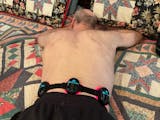Investigating the Possibilities of Photobiomodulation Therapy for Fibromyalgia
Fibromyalgia is a long-term condition marked by widespread pain, fatigue, sleep problems, and cognitive difficulties. Although it is common, there are few effective treatments for fibromyalgia, so it is important to consider new and creative therapeutic options. One potential option is photobiomodulation therapy (PBMT), a non-invasive treatment that utilizes light to activate cellular processes and encourage healing.
What is Photobiomodulation Therapy?
Photobiomodulation therapy (PBMT) employs low-level lasers or light-emitting diodes (LEDs) to provide targeted wavelengths of light to the body. This light penetrates the skin and interacts with cellular components to alleviate pain and inflammation, improve circulation, and facilitate tissue repair. Traditionally, PBMT has been localized to specific areas of pain or injury. However, recent studies propose that whole-body PBMT may offer comprehensive benefits for FM patients by addressing multiple symptom domains simultaneously.
Recent Findings on Whole-Body PBMT for Fibromyalgia
An investigation into the impact of whole-body PBMT on individuals with FM was carried out in a recent single-arm feasibility study. The study, conducted following CONSORT guidelines, sought to evaluate the feasibility and potential effectiveness of this treatment approach. The primary measure of outcome was the Revised Fibromyalgia Impact Questionnaire (FIQR), which measures the overall impact of FM on a patient's life.
The study involved 21 participants, 19 of whom completed the intervention, which consisted of 18 whole-body PBMT sessions over approximately six weeks. The results were promising, indicating positive changes in several FM-specific symptoms, including:
- Quality of Life: Participants noted substantial enhancements in their overall quality of life.
- Pain and Tenderness: The hallmark symptoms of FM, such as pain and tenderness, showed a significant decrease.
- Stiffness and Fatigue: Enhancements in rigidity and tiredness thresholds were noted, leading to improved daily performance.
- Sleep Disturbance: Improved sleep quality was observed among the participants, a critical factor in FM management.
- Anxiety and Depression: The treatment also demonstrated promise in easing anxiety and depression, which are frequently seen together in patients with FM.
- Cognitive Impairment: There were positive changes in cognitive function, often referred to as “fibro fog.
Furthermore, patient global assessment revealed sustained improvements at six weeks, with continued benefits observed at 24 weeks post-treatment.
Implications for Future Research and Treatment
The results of this preliminary study lay a solid groundwork for a larger trial to delve deeper into the effectiveness of whole-body PBMT in treating FM. The enhancements in quality of life and different symptom areas highlight the promise of this innovative non-invasive therapy in providing substantial relief for FM sufferers.
Individuals with fibromyalgia may see significant progress in managing their condition with the potential adoption of PBMT as a widely-used treatment option. The incorporation of PBMT into medical practice has the potential to transform the treatment of fibromyalgia, providing optimism and enhancing the quality of life for countless individuals affected by this condition.
Conclusion
Photobiomodulation therapy shows significant potential as a successful remedy for fibromyalgia. The encouraging results from recent research emphasize the possible advantages of this groundbreaking method, prompting the need for more extensive and thorough examinations. By adopting progressive treatments such as PBMT, we can make strides towards offering fibromyalgia patients the much-needed relief they seek.
















Share:
Exploring the Immediate Benefits of Multi-Focal Low-Level Laser Therapy on Quadriceps in Knee Osteoarthritis Patients
Revolutionizing Pain Relief: Red and Violet Laser Therapy for Neck and Shoulder Pain